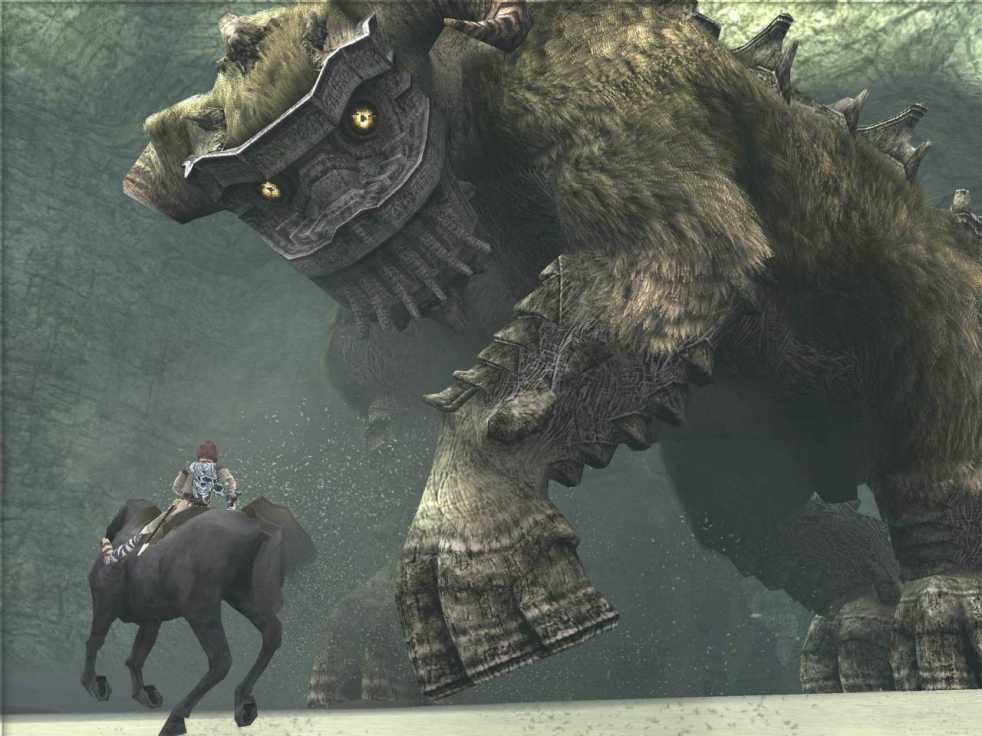She’s dead, but I refuse to accept it. A wake of doves flutter around the altar on which she lies. Her skin used to be as white as their feathers. But now it seems to glow slightly. The sunlight is honeying between the pillars. The landscape outside stretches uninterrupted by civilization as far as the eye can see. This country is uninhabited. Almost. Your horse whinnies gently next to you. Monolithic bodies of stone and earth and fur groan as colossi shift in their hidden groves and lakes and valleys. One by one they fall. One by one their idols crumble. Her skin glows a little more. On your head grow horns.
Shadow of the Colossus is a game that reveals its story by playing it.
Before it ever became the avatar for the debate on whether or not video games are art, I decided Shadow of the Colossus was the best game I had ever played. It was a Christmas present, and I spent that whole day discovering video games can be experienced, not just played. The first colossus took my breath away. Video games tend to be power trips. Fighting gigantic bosses, is standard fare. But the protagonists are endowed with powers that make the fight fair, if not tilted in your favor. The nameless boy standing as an ant beneath a tower of rock was armed with a sword and a bow. I never felt so powerless. When I delivered the final blow, I never felt so strong.
And then the music played. The colossus collapsed, the nameless boy thrown off to land next to the lifeless hunk of earth. Something was wrong. The song was in a minor key. The colossus failed to explode or roar or die cursing your name. It simply died. And instead of feeling a hero, I felt a murderer. The black snaked out of its dying body and impaled me. When I next awoke, it was back at the temple. Back before the altar on which she lay. As the cycle wore on, slay the colossus, be consumed by black, awake in the temple, a question nagged at me. What cost was I paying?
Never before had a video game made me ponder this. When killing your enemies, rewards usually flow. Receive new weapons, gain experience, become stronger; these are what you reap from the corpses of your foes. Here, you gained a slight boost to strength, but the change I noticed were the bumps growing at my temples, the paling of my face. Could I truly say I was gaining?
That hesitation where I wonder what right i have to slay this creature I could even describe as beautiful.
The mysteries of the story are ostentatious and wonderful. What are the structures that dot this forbidden country? Why is it forbidden? Where did the colossi originate? How did the girl die? Who is she to the boy? Sister? Lover? Friend? The elegance of this absence of answers is akin to the artistic concept of negative space. These aren’t explained on purpose, not because the developers were lazy. It’s up to you to wander the land and come to your own conclusions. What shape does the absence make? What patterns emerge when you stare at what isn’t there? Once you start looking, how does it change what you can see?
Shadow of the Colossus is a game that reveals its story by playing it. Not through dialogue. Not through narration. Not through notes scattered in the land. Through experiencing it. I continue to discover new details I hadn’t noticed before. I’ve played many great games since then. But none of them replicate that feeling I have right before I plunge the sword into the great beasts for the killing blow. That hesitation where I wonder what right I have to slay this creature I could even describe as beautiful.
I kill colossi. And I feel like the monster.
